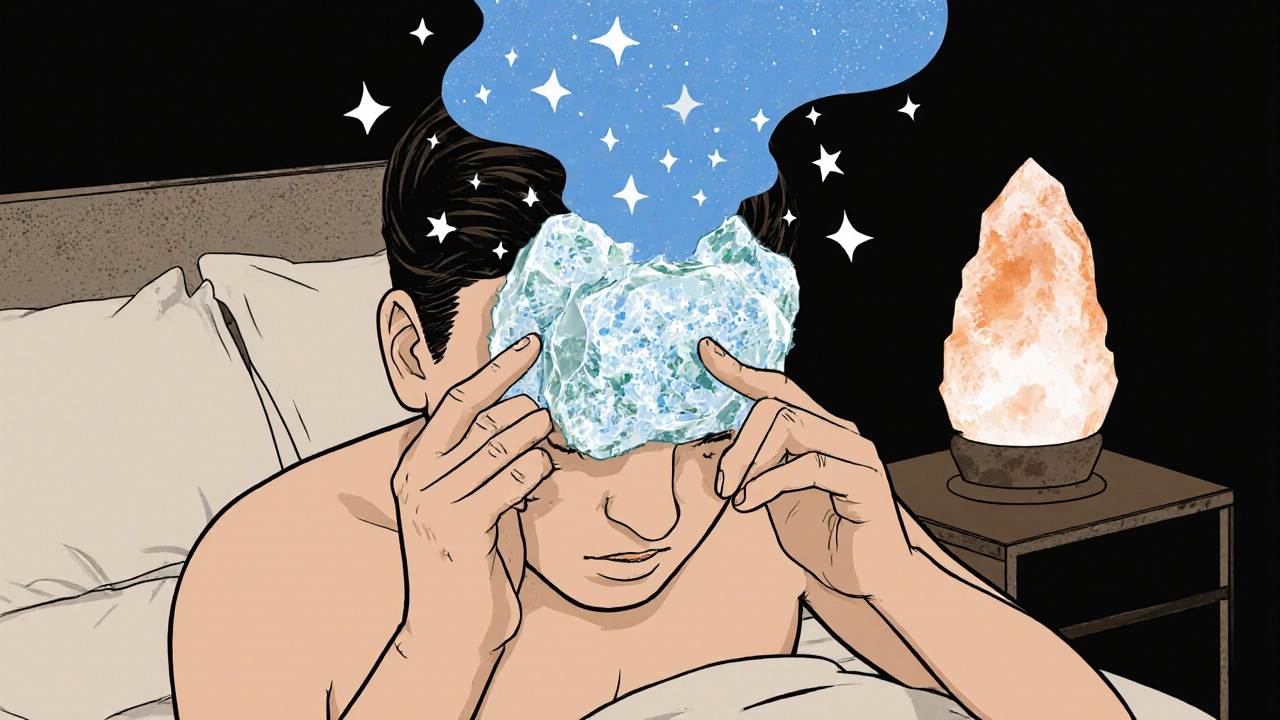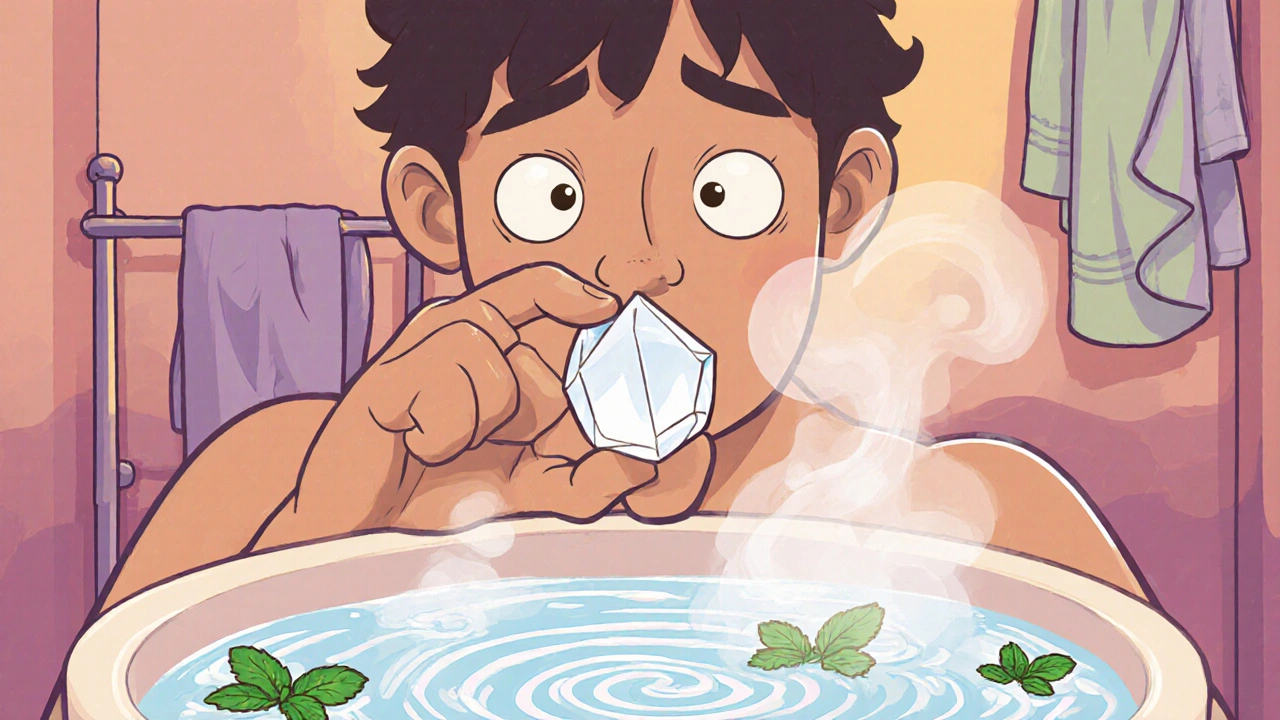Most people know menthol as the cooling sensation in cough drops or muscle rubs. But if you’ve ever held a small white crystal in your hand and wondered what it could do, you’re looking at pure menthol - the concentrated form that’s been used for centuries in traditional remedies. Unlike store-bought products with fillers and fragrances, menthol crystals are 99% pure. That means they’re powerful. And when used right, they can help with everything from sore muscles to stuffy noses - without needing a prescription.
What Are Menthol Crystals?
Menthol crystals are a solid, crystalline form of menthol, a natural compound found in mint plants like peppermint and spearmint. They’re made by cooling and purifying mint oil until the menthol separates into clear, needle-like crystals. These crystals melt at body temperature, releasing a strong, cooling vapor. You won’t find them in most drugstores because they’re not meant to be swallowed or applied directly to skin without dilution. But if you know how to handle them, they’re one of the most versatile natural tools you can keep at home.
They’re not the same as menthol oil or mentholated creams. Crystals are dry, solid, and odorless until warmed. Once activated, they release a sharp, clean menthol scent that clears your sinuses and soothes aching muscles. They’re also used in aromatherapy, DIY balms, and even in some traditional Chinese and Ayurvedic remedies.
How to Use Menthol Crystals for Congestion and Breathing
If you’ve ever woken up with a blocked nose, you know how frustrating it is. Menthol crystals can help - fast.
Here’s how: Place two or three crystals in a small bowl, then pour hot (not boiling) water over them. Let it sit for a minute. Now lean over the bowl, cover your head with a towel, and breathe in slowly through your nose for 5 to 10 minutes. The steam carries the menthol vapor deep into your nasal passages, opening up airways and reducing swelling. It’s like a natural decongestant that works without chemicals.
People with seasonal allergies, colds, or even mild asthma find this method helps them sleep better. One study from the University of Michigan found that menthol vapor improved nasal airflow in 87% of participants with congestion - without side effects like drowsiness.
You can also add a single crystal to a humidifier (if it’s designed for essential oils). Just don’t put it in directly - melt it first in a separate container and add the liquid. Never put crystals into a steam vaporizer meant for water only - they can damage the machine.
Using Menthol Crystals for Muscle and Joint Pain
After a long day on your feet or a tough workout, aching muscles can feel unbearable. Menthol crystals can bring quick relief - if you mix them properly.
Start by crushing one crystal into a fine powder using a mortar and pestle. Then mix it with two tablespoons of coconut oil or almond oil. Stir well until the crystals fully dissolve. Let it sit for 30 minutes so the menthol fully infuses the oil. Now rub a small amount onto sore shoulders, knees, or lower back. The cooling effect kicks in within seconds and lasts up to an hour.
This works because menthol tricks your nerves into feeling cold instead of pain. It doesn’t heal the injury, but it blocks the pain signals long enough for your body to recover. Many physical therapists in Australia use this method as a low-cost, drug-free option for patients with arthritis or sports injuries.
Important: Never apply undiluted crystals to skin. They’re too strong. Always mix with a carrier oil. Test on a small patch first - some people get mild redness or tingling, which is normal. If it burns, wash it off with soap and water.
Menthol Crystals for Headaches and Tension
Tension headaches often start behind the eyes or at the base of the skull. Menthol can calm that tight, throbbing feeling.
Take one crystal and gently rub it between your fingers until it warms up and starts to release vapor. Then dab the slightly oily residue on your temples, forehead, and the back of your neck. The cooling sensation distracts your brain from the pain signal. Some people find this works better than over-the-counter painkillers.
For a deeper effect, add a crushed crystal to a cold compress. Soak a clean cloth in cold water, squeeze it out, sprinkle a tiny bit of crushed menthol on it, and lay it across your forehead. Keep it there for 10 minutes. The cold + menthol combo reduces inflammation and tightness in the muscles around your head.

DIY Menthol Inhalers and Room Diffusers
You don’t need fancy equipment to make your own menthol inhaler. Grab an empty plastic inhaler tube (sold online or in aromatherapy shops) or even a small glass vial with a cap. Put one or two crystals inside. Close it tightly. When you need relief, just hold it under your nose and breathe in through your nose. The crystals slowly release menthol vapor as they warm up from your hand.
For a room diffuser, place three crystals in a small ceramic dish near your bed or desk. Add a drop of water every few hours to help them release scent slowly. The room will smell fresh and clean - and you’ll breathe easier. This works great in stuffy offices or during allergy season.
Don’t leave crystals out in open air for long - they slowly evaporate. Store them in a sealed glass jar in a cool, dark place. They last for years if kept dry.
Can You Use Menthol Crystals in Baths?
Yes - but carefully. Add no more than one crystal to a full bathtub of warm water. Let it dissolve completely before getting in. The menthol will cool your skin and relax your muscles. It’s especially soothing after exercise or on cold days.
Warning: Never use more than one crystal per bath. Too much can irritate sensitive skin or cause dizziness. If you have open cuts, eczema, or are pregnant, skip the bath method. The absorption through large areas of skin can be too strong.
Safety First: What Not to Do
Menthol crystals are powerful. Misuse can cause harm.
- Never swallow them. Ingesting even one crystal can cause nausea, vomiting, or in rare cases, seizures.
- Don’t apply directly to skin. Always dilute with oil or water.
- Avoid eyes and mucous membranes. If crystals get in your eye, rinse with cool water for 15 minutes and seek help.
- Keep away from children and pets. They look like sugar or salt. Accidental ingestion is dangerous.
- Don’t use if pregnant or breastfeeding. There’s not enough research to say it’s safe in large amounts.
- Stop use if you feel dizzy or lightheaded. It’s a sign you’re getting too much vapor.
Store menthol crystals in a labeled, childproof container. Keep them in the fridge if you live in a hot climate - they melt at 42°C (108°F).

Where to Buy High-Quality Menthol Crystals
Not all menthol crystals are created equal. Some are synthetic or mixed with additives. Look for products labeled "USP Grade" or "Pharmaceutical Grade" - this means they meet purity standards used in medicine.
In Melbourne, you can find them at natural health stores like The Natural Pharmacist or online through suppliers like Mountain Rose Herbs or Bulk Apothecary. Avoid cheap crystals sold on general marketplaces - they often contain fillers or are not food-grade safe.
Price varies from $10 to $25 for 100 grams. A little goes a long way - one gram can last months if used sparingly.
Alternatives to Menthol Crystals
If you’re not comfortable using crystals, there are safer, ready-made options:
- Menthol oil - diluted and ready to use. Good for topical applications.
- Menthol balms - like Tiger Balm or Vicks VapoRub. Easy, but contain other ingredients.
- Peppermint essential oil - contains about 40% menthol. Less concentrated, but still effective.
But if you want the purest, most potent form - and you’re willing to take a few extra steps - menthol crystals are unmatched.
Can menthol crystals be used for children?
No. Children under 12 should not use menthol crystals. Their skin is more sensitive, and their bodies process menthol differently. Even diluted forms can cause breathing issues in young kids. Use pediatric-safe products like saline sprays or gentle humidifiers instead.
How long do menthol crystals last?
Properly stored in a sealed glass jar away from heat and light, menthol crystals can last for years - even decades. They slowly evaporate over time, so if you notice the crystals shrinking or becoming powdery, they’re losing potency. Still safe to use, but less effective.
Can I use menthol crystals with other essential oils?
Yes. Menthol pairs well with eucalyptus, peppermint, and lavender oils. For a chest rub, mix one crushed crystal with 10 drops of eucalyptus oil and two tablespoons of coconut oil. Always test on a small area first. Never combine with strong irritants like cinnamon or clove oil.
Do menthol crystals help with coughs?
They can ease coughing by soothing irritated throat tissues and reducing mucus buildup. Inhaling the vapor helps relax the airways. But they don’t treat the cause of the cough - like a virus or infection. Use them as a temporary relief, not a cure.
Is menthol the same as mint oil?
No. Mint oil is a mixture of many compounds, including menthol, menthone, and limonene. Menthol crystals are over 99% pure menthol. That’s why crystals are stronger and more concentrated. One crystal equals about 10 drops of peppermint oil in potency.
Final Thoughts
Menthol crystals aren’t magic. But they’re one of the few natural remedies that actually work - fast, reliably, and without side effects when used correctly. Whether you’re dealing with a stuffy nose, a sore shoulder, or just need to clear your head, they offer a simple, low-cost solution. The key is respect: treat them like medicine, not a novelty. Store them safely, dilute them properly, and use them only when you need the power they offer. Once you’ve tried them the right way, you’ll wonder how you ever managed without them.



Andy Slack
Menthol crystals are a game changer for my sinus issues. I use the steam method every night before bed and I swear I sleep like a baby now. No more nasal congestion, no more mouth breathing. Just pure, clean air. I keep a small jar on my nightstand and it’s become part of my routine like brushing my teeth.